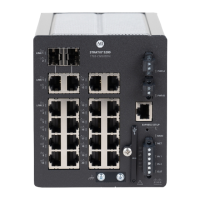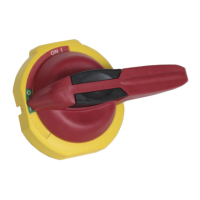6 Rockwell Automation Publication 1783-IN013B-EN-P - December 2019
Stratix 5800 Ethernet Managed Switches
Required Tools
Obtain these tools:
• Ratcheting torque screwdriver that exerts up to 2.03 N•m (18 in•lb) of pressure
• For the protective ground connector, obtain one or two stu size 6 ring terminals
•Crimping tool
• 10-gauge copper ground wire
• For DC power connections, use UL- and CSA-rated style 1007 or 1569 twisted-pair copper appliance wiring material (AWM) wire
• Wire-stripping tools for stripping 10- and 14-gauge wires
• A number-2 Phillips screwdriver
• A flat-blade screwdriver
For better EMC performance, we recommend that you use S/UTP or SF/UTP cables for copper Ethernet ports. For details on S/UTP and
SF/UTP, refer ISO/IEC11801 standard.
For simplified cabling, the automatic medium-dependent interface crossover (auto-MDIX) feature is enabled by default on the switch. With
auto-MDIX enabled, the switch detects the required cable type for copper Ethernet connections and configures the interfaces accordingly. You can
use a crossover or a straight-through cable for connections to a 10/100/1000 port, regardless of the device on the other end of the connection.
Site Requirements
Observe these site requirements:
• The device must be installed in vertical position.
• For 10/100/1000 ports, the cable length from a switch to an attached device cannot exceed 100 m (328 ft).
• For 100Base-FX fiber-optic ports, the cable length from a switch to an attached device cannot exceed 2 km (6562 ft).
• Clearance to front and rear panels must meet these conditions:
– Front-panel status indicators are easily read.
– Access to ports is sufficient for unrestricted cabling.
– Front-panel direct current (DC) power and relay connectors are within reach of the connection to the DC power source.
• Airflow around the switch is unrestricted. To help prevent the switch from overheating, observe these minimum clearances:
– Top and bottom: 50.8 mm (2.0 in.)
– Left and right: 50.8 mm (2.0 in.)
– Front: 50.8 mm (2.0 in.)
• For installation in hazardous locations, make sure that the temperature surrounding the unit does not exceed the maximum operating
temperature of the device. See the specifications on
page 15.
• Cabling must be away from sources of electrical noise, such as radios, power lines, and fluorescent lighting fixtures.

